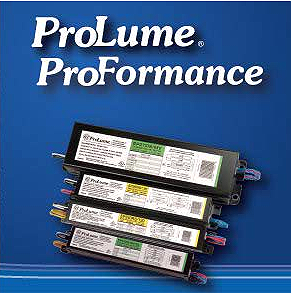Which Fluorescent Ballasts Improve Lighting & Offer High Efficiency Savings
One of the biggest problems with Fluorescent Lighting and light fixtures is and has always been a lack of public awareness as to the products being used. Typically a consumer or facility maintenance department know what kind of bulbs they need for a fixture, and when it comes time for a ballast, they seek “A Ballast” that would appropriately run the number and type of lamps being used.
There Are Many Types of Fluorescent Ballasts
Manufacturers such as Sylvania, Advance, GE and Prolume, (Many others), all make fluorescent T8 ballasts. What most people do not know is they make many different kinds all for the same lamp combination. These include:
- Residential Grade Ballasts
- Standard General Ballast
- CEE Rated High Efficiency Ballasts
Each of these varying grades of fluorescent electronic ballasts are available in 120 Volt, 277 Volt and Universal Voltage. Not only are they available in varying voltages, but they as well have a great variance as to the characteristics, energy consumption, light output and bottom line price.
The Benefits of Ballast Types & Pricing
Residential Grade Ballasts
Electronic Fluorescent Ballasts made for residential use are very common and typically found pre-installed in fluorescent fixtures available at stores like Home Depot and Lowes. The fixtures from these sources often carry a lower price than those available from commercial electric or lighting companies with the only difference being the ballast installed. The Residential or (GEB) Generic Electronic Ballast, are made with lower usage requirements such as 3 hours use per day. They have a smaller and less expensive electrolytic capacitor that when used for extended periods of time, crystallizes internally and fails. These ballasts when used in a commercial application rather than as a “Garage Light” usually fail with a year or two. Ballast cost @ $12.00 each.
See: Advance Residential Ballast Brochure
Standard General Ballasts
Standard ballasts are designed for use in retail and offices with run times averaging 8-10 hours per use daily. Typically this is the “Normal” ballast you will receive when asking a supplier for a ballast. These are readily available, and often come with very competitive pricing from distributors @ $15.50 to $21.oo per ballast. The quality of these ballasts are average, however they last @ 3 -5 years maximum life and only carry a warranty longer than 3 years if installed with the same brand lamps as the ballast manufacturer. There is no energy benefits when using standard general ballasts, other than understanding that they operate with a ballast factor of 88%, which means the lamps are putting out 12% less light. Examples of a stadard use ballast: Sylvania Quicktronic (QTP4x32T8 ISN-SC)
Beware: This is the ballast that most companies sell 100% of the time. Claims of “Best Quality, Professional Series or Commercial Grade” are misleading as it is intended for light use only, not heavy duty or energy efficiency. See: Sylvania Quicktronic BrochureCEE Rated High Efficiency Ballasts

High Efficiency Ballasts are considered to be the “Best Quality, Most Efficient” ballasts available in today’s market. These ballasts which meet the efficiency standards of Energy Star and (CEE) Consortium For Energy Efficiency provide maximum light output of 95% of the design lumen output and producing up to 99.8 lumen’s per watt. These are excellent choices for office, warehouse such as Fluorescent High Bay fixtures as well as retail store lighting.
This means brighter light, greater energy savings and a complete 5 year factory warranty no matter how many hours of use in any application.
See: Halco High Efficiency Brochure
For more information view our website or call Synergy Lighting for a free consultation. Phone: (941)-756-4844
Toll Free: (877) 220-5483
e-mail: sales@synergylightingusa.com
 Sylvania, Philips, GE and many other manufacturers use a Standard Tungsten-Alloy Filament stretched between two filament supports. Unlike the Pure Tungsten Filaments invented by Thomas Edison, and used in most Industrial Grade Bulbs, the tungsten-alloy filament is weaker and does not hold up as long. This may be part of planned obsolescence, or a way to get a consumer to buy more bulbs. Industrial Grade lamps such as Halco, Superior Life Lamps use Pure Tungsten filaments with additional filament supports. This increase lamp life and stability when subjected to Heat, Vibration and Power Surge.
Sylvania, Philips, GE and many other manufacturers use a Standard Tungsten-Alloy Filament stretched between two filament supports. Unlike the Pure Tungsten Filaments invented by Thomas Edison, and used in most Industrial Grade Bulbs, the tungsten-alloy filament is weaker and does not hold up as long. This may be part of planned obsolescence, or a way to get a consumer to buy more bulbs. Industrial Grade lamps such as Halco, Superior Life Lamps use Pure Tungsten filaments with additional filament supports. This increase lamp life and stability when subjected to Heat, Vibration and Power Surge.
